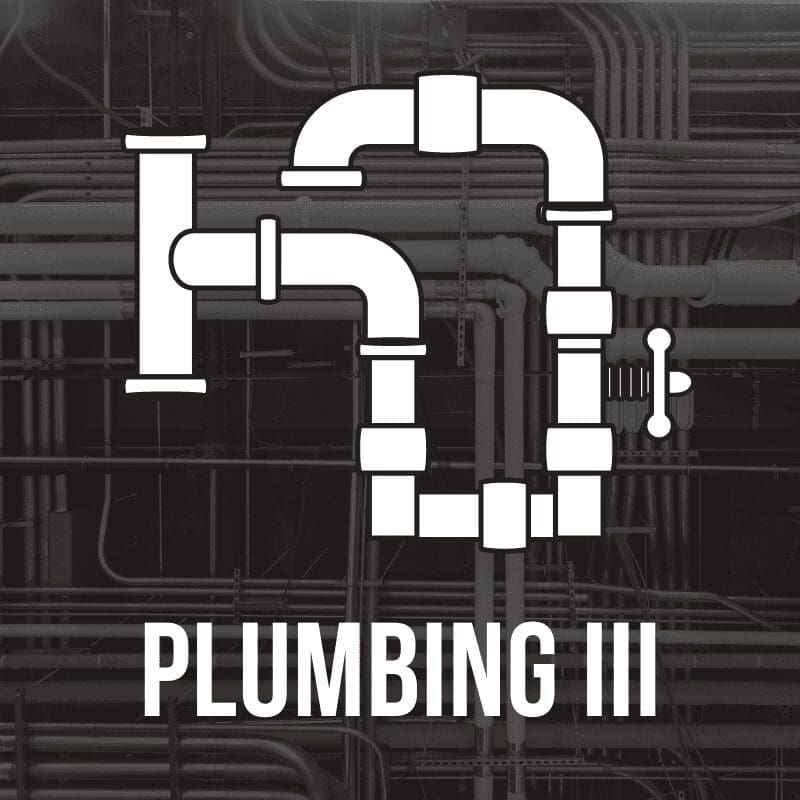Plumbing II
Expanding on the skills learned in Plumbing I, WMCI’s intermediate Plumbing training course will continue to advance students’ education with a deeper dive into the commercial plumbing industry.
Registration for Plumbing II is now closed for the Fall ’24 semester.
Make sure to join the WMCI mailing list to be notified first when this class is open for enrollment again.

Course Description
Plumbing II helps students gain proficiencies in plumbing-related math and reading construction documents as it relates to their field. Students will also explore installation processes for drain, waste, and vent systems.
Prerequisites: Plumbing I or Employer Approval
Course Details
- Dates: August 21, 2024 - June 4, 2025
- Day of the Week: Every Wednesday
- Time: 4:30 - 8:30PM
- Tuition: $4,000 ($2,000 per semester)
- Material/Lab Fees: $250
- Course Textbook Fee: $125
Credentials Earned
- NCCER Plumbing II Certification
- WMCI Certificate of Completion
What you'll learn in plumbing II
course curriculum
Plumbing Math TWO
Explains the Pythagorean theorem and reviews methods for laying out square corners. Discusses the techniques used to calculate simple and rolling offsets, as well as offsets on parallel runs of pipe.
Reading Commercial Drawings
Explains how to identify and interpret civil, architectural, structural, HVAC/mechanical, plumbing, and electrical drawings. Discusses how to ensure accurate dimensions, generate RFIs, and locate plumbing entry points, as well as how to establish piping routes and fixture locations. Isometric drawings, material takeoffs, approved submittal data, and Building Information Management (BIM), are also covered.
Structural Penetrations, Insulations, and Fire-Stopping
Introduces methods for adjusting structural members, insulating pipe, and installing fire-stopping. Covers reinforcement techniques for modified structural members; how to measure, cut, and install fiberglass and flexible foam insulation; and how to identify walls, floors, and ceilings that require firestopping.
Installing and Testing DWV Piping
Explains how to locate, install, connect, and test a complete drain, waste, and vent (DWV) system. Discusses how to develop material takeoffs, set up and use levels, locate building sewers and building drains, locate fixtures, and test a DWV system.
Installing Roof, Floor, and Area Drains
Covers the proper techniques for locating, installing, and connecting roof, floor, and area drains and floor sinks according to code. Discusses waterproof membranes and flashing, drain components, shower pans, trap primers, and proper drain applications.
Installing and Testing Water Supply Piping
Explores the proper techniques for locating, installing, and testing complete water service and distribution systems, including meters, water heaters, water softeners, and hose bibbs. Introduces basic backflow and water hammer prevention, and discusses the installation of shower and tub valves, ice maker and washing machine boxes, and pipe stubouts and supports.
Types of Valves
Reviews types of valves, their components, and applications. Also covers valve servicing.
Installing Fixtures and Valves
Covers the installation of basic plumbing fixtures, including bathtubs, shower stalls, lavatories, sinks, water closets, and urinals. Reviews the installation of associated valves, faucets, and components. Explains how to connect appliances such as dishwashers, food-waste disposers, refrigerators and ice makers, and washing machines.
Installing Water Heaters
Discusses gas-fired, electric, tankless, heat pump, and indirect water heaters, components, and applications. Reviews proper installation and testing techniques and covers the latest code requirements for water heaters.
Basic Electricity
Introduces electrical safety and the principles of electricity including voltage, current, resistance, and power. Includes important electrical formulas, circuitry, and common plumbing-related electrical applications.
Fuel Gas and Fuel Oil System
Introduces techniques for safe handling of natural gas, liquefied petroleum gas, and fuel oil. Reviews fuel gas and fuel oil safety precautions and potential hazards, applications, systems installation, and testing.
Plumbing II Registration Form
Registration for Plumbing II is now closed for the Fall ’24 semester.












